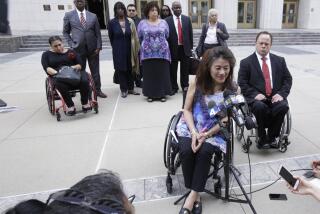U.S. Fines Union Pension Trustees : Alleges Cut-Rate Loans Went to Southland Contractors
- Share via
After a three-year investigation, the Department of Labor has concluded that trustees of two Southern California construction industry pension funds improperly made loans at below-market interest rates to stimulate construction and create jobs.
Both management and union trustees of pension funds for members of the carpenters and plumbers unions denied the charges, but have agreed with the Department of Labor to terms of a consent decree that will be submitted to a federal court judge Jan. 14 for approval.
Under terms of the proposed decree, the 24 trustees of the two funds will be penalized about $1.5 million for making the allegedly cut-rate loans to developers. The penalties will be paid into the pension funds by insurance companies. The trustees were not accused of any personal misuse of the funds and were not asked by the government to resign their positions as trustees.
The proposed consent decree would require the trustees to hire an independent, outside expert in real estate financing to review terms of future loans, and that expert’s appointment would be subject to approval by the Department of Labor.
The pension fund loans were made through the Development Foundation of Southern California, which is composed of management and union trustees of 12 separate construction industry unions, which together have assets of more than $2 billion. Only the funds of the plumbers and carpenters were investigated by the government, however.
A government expert involved in the case, who asked not to be identified, said that an investigation of 20 loans showed that trustees of the two funds made loans or loan commitments totaling more than $82 million, and “lost” about $9 million for the funds by making the loans at interest rates from 2.4% to 5.4% below market rates.
“It is a simple enough situation,” the official said. “The law says the prime consideration of pension fund investments must be for beneficiaries of the funds, and we say the trustees could have made more money than they did for the beneficiaries if they had invested their money at going interest rates.”
Figures Challenged
But leaders of the pension funds insist that they did invest money at going market rates and that the government’s figures are incorrect. Both government and pension fund trustees agree that one complexity in the case is the need for the investors to estimate future rates of interest.
Loan commitments are made before the actual money is disbursed to a borrower, and the pension fund trustees say they used their best judgment to estimate what future interest rates would be. The government argued, however, that the trustees’ estimates were wrong and that loans were thus made at below-market rates, which is a violation of federal pension laws.
The trustees also maintained that not only did the pension fund beneficiaries get “top dollar” from the investments, but those loans also created hundreds of new jobs in the depressed housing industry.
One pension fund executive, who also asked not to be named, said: “We did not want to accept the consent decree terms because we were not guilty. But our insurance companies insisted on a settlement because they felt the $1.5-million penalty was a sum they would rather pay than to risk a possible higher penalty after years of a trial.”
One reason the investigation lasted so long, the government official explained, was that “we had our experts look at the figures and then the pension fund trustees hired their expert (Robert Edelstein, economist at the Wharton School of Business) who contradicted our experts. So we had to hire more experts for the government and it became a battle of the experts trying to determine the proper interest rates.”
More to Read
Sign up for Essential California
The most important California stories and recommendations in your inbox every morning.
You may occasionally receive promotional content from the Los Angeles Times.













